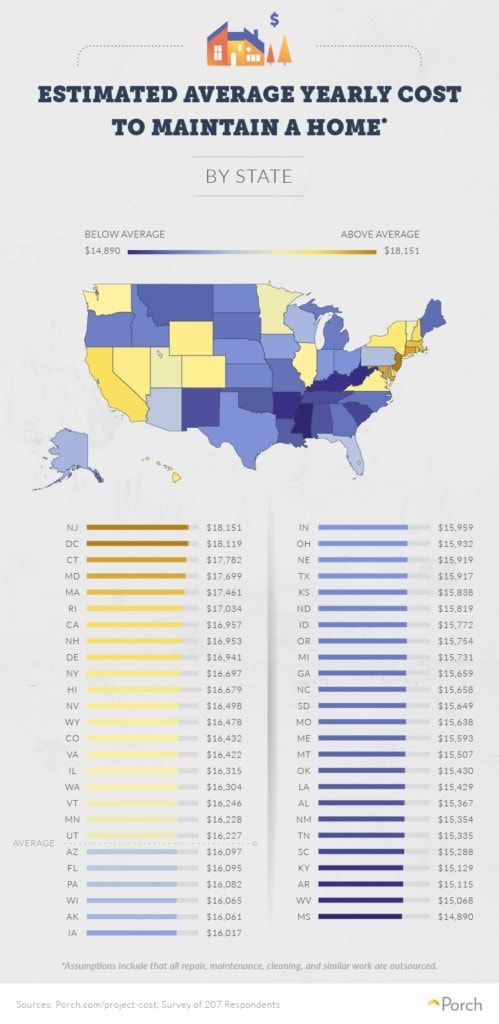Last Updated on October 11, 2023
New home? Congrats!!! Now what’s the key to getting (and keeping) your home comfortable and operating smoothly both inside and out? A well-executed home maintenance plan. Admittedly, creating a home maintenance plan it’s not exciting BUT it’s a necessity to keep your family and home safe. Here’s a easy 4-step strategy to set up a home maintenance plan for a new house.

This post contains affiliate links, including but not limited to, Amazon Associates. As such, I earn from qualifying purchases. Full disclosure located here.
Backstory
When we bought our first home 10 years ago, I was absolutely elated to finally own a home. I felt so responsible. I felt so proud.
But I also felt overwhelmed. And paralyzed as to what to do next.
I finally own a house. Yippee!!! Now what? How I do to maintain it?
My other large expense – my car – had a maintenance manual. Where was my home’s maintenance manual? Why didn’t my home come with a maintenance manual just like my car?
Luckily (or unluckily depending on how you see it ?), I worked in Corporate America for over 20 years. And I endured seminar upon seminar about strategy and planning. And what was one of the biggest take-aways? “Plan the Work, and Work the Plan”.
In other word, I needed plan out my new home’s maintenance….and then work that plan!
Why Do You Need to Set Up a Home Maintenance Plan?
The reasons behind creating a home maintenance plan for a new house is not rocket science. Homeowners who neglect performing regular home maintenance are more likely to risk incur large and costly surprises.
And if you don’t keep on top of home maintenance, the home will spiral into disrepair. Which leads to a decrease your home’s value, making it harder to sell down the road.
Before You Start..
As a homeowner of a new house, you have this important question to answer that will set the tone for home maintenance:
Do you want to be proactive or reactive to your home’s needs?
Which is it? Be proactive and stay on top of home maintenance? Or reactive, waiting until something breaks, then running around like a chicken with its head cut off trying to fix it?
Personally, being reactive is exhausting. I choose proactive.
Sure, creating and implementing a home maintenance plan takes time and effort. But it WILL pay off. How?
- Translates to lower home repair costs (and a thicker wallet)
- Gives you peace of mind
4 Steps to Set Up a Home Maintenance Plan for a New House
After we bought out new house, we scrambled to figure out what to do first. Eventually we figured it out, but it took a bit longer than it probably should have. Knock-on-wood, 10 years later we haven’t run into any costly surprises! Since we do plan to buy another house in a few years (we are out growing this one), so I’m working towards being better prepared for the next move!
Here’s the 4 steps to creating a home maintenance plan for a new house:
- Assess
- Prioritize
- Plan
- Execute
FYI: This post is just a general overview of the process. Future posts will dive deep into the process, like my more recent 5 Types of Home Maintenance Every Homeowner Should Know. Be sure subscribe to my monthly newsletter to get notice of the latest and greatest info!
1. Assess
The objective of this first step is the learn the condition of your home. Ask yourself this question:
What the heck needs to be done?
To get your arms around this question requires casting a wide net to understand the condition of your home’s components. What exactly are your home’s components? Everything that’s attached to the house, broken into these 3 categories:
- Structural – foundation, frame, roofing
- Functional – windows/ door, plumbing, electrical, HVAC
- Finished – siding/ gutters, walls, flooring interior finishes
For most homeowners, that might mean hiring professional help in the form of a licensed inspector. And if you just bought your house, then you can rely mainly on your home inspection.
Our home inspection was a treasure trove of information to help us create our home maintenance plan. This powerful tool gave us a “lay of the land” – what was new, what was old, and what needed to be repaired or replaced.
If you didn’t hire a professional, you can still assess your home. It can be as simple as using a keen eye and slowly walking around your house room by room.
Write down everything you need to repair, replace or maintain (or enter into a spreadsheet). Include all projects – small and large. Don’t fret if your list is pages long. It’s actually meant to be an exhaustive list. Especially if you just purchased an old house and taking on all the challenges that come with it.
Feeling overwhelmed? Don’t be. Take a deep breath (as we tell our daughters when they get worked up: “Smell the flowers, blow out the candles”). Just remember, this is the first step to transforming your house into the home of your dreams.
Next, we organize that list into manageable pieces…..
2. Prioritize
The primary goal of setting up a home maintenance plan for a new house is to first tackle the urgent priorities. Everything else will fall into place later.
The essential question to answer in this step is:
When what needs to be done right now? What’s urgent? What can wait?
This step requires ranking all the home maintenance tasks to tease out the priorities. In descending order of importance, rank your exhaustive list into these 4 categories:
- Safety Concerns
- Water Damage
- Utilities and Appliances
- Everything Else
1. Safety Concerns
Safety in your new home needs top billing in your home maintenance plan. The following should be urgent items on your to-do list:
- Fire Prevention: test smoke and carbon monoxide detectors, check fire extinguishers, ensure highly visible house numbers
- Security: Install dead bolt locks and motion sensitive lighting to prevent theft
- Slips, Trips and Falls: Fix wobbly bannisters, install childproof gates, non-slip tools for young or older family members
Luckily, the majority of these items are fairly inexpensive, and you can tackle them by yourself.
2. Water Damage
Rain, wind, and the outdoor elements are one of the biggest enemies of your home. Water can easily seep through walls and soak drywall, insulation, even structural supports. If left unchecked, it can cause severe structural damage and significant mold issues. And the restoration process can be expensive and time-consuming.
Here’s where to look for leaks, gaps or evidence of water damage on the outside of your home:
- Roof and Chimney
- Foundation and Masonry
- Under siding
- Windows and Doors
- Clogged Gutters and Downspouts
Once that’s done, the next step is to look inside for leaks (or potential leaks) with your home’s interior plumbing and tackle any potential concerns.
Some of these – like a new roof – is expensive. But luckily, some of these urgent to-dos, such as caulking around windows or filling in cracks in exterior doors – costs only a few dollars.
It is ESSENTIAL to address any water damage and seal up the envelope (or exterior) of your house first and prevent future damage (and more work!).
And sealing up your home’s exterior does more than just stop the water from coming in and doing damage. It also stops pests and termites from entering. Plus, it increases the energy-efficiency of your home. Talk about killing two birds with one stone!
This will probably sound kooky, but I consider the building envelope the “skin” of our homes. Like our bodies, our skin protects everything inside our homes. Protect your skin, and it will protect you…
3. Home Utilities
While the exterior of a house is the skin, the home utilities are the heart and lungs of the house. They need to be in tip-top shape to work effectively and efficiently. [BTW – I consider both past and present homeowners the soul of the house.]
What are your home’s utilities: electrical, heating, air conditioning, and plumbing. And for ease, I also lump large appliances (i.e. refrigerators, ovens, stoves, dishwashers, washers, dryers, etc…).
Where are my home systems?
At a minimum, get to know your systems. Locate your water and gas mains, determine your type of heating and cooling, locate your electrical panel and label it with this free template.
How old and in what condition is it?
To determine the age of systems and appliances, examine the units for any tags or labels directly on the unit. Then, for the older systems and appliances, ask yourself if have they reached their lifespan? How old is too old? Are they still in working condition? If so, when should be consider proactively replacing it?
How much does it cost to operate?
Determining the cost to operate some systems and appliances can be tricky. Reach out to your local utilities to schedule an energy audit to get a better understanding on how to increase energy efficiency. Most utility companies offer these for free or at a low cost. If not possible, you can perform your own DIY home energy audit.
From these energy audits you can determine strategies to make your home more energy-efficient, ranging from the simple and inexpensive (programmable thermostat, LED-lightbulbs) to the more complicated and expensive (new furnace, more insulation).
How much maintenance does it need?
While you are focused on home utilities, now is the perfect time to think ahead and create your reoccurring home maintenance schedule. For example, either create or download home maintenance checklists. There’s a ton of checklists online – whether monthly, seasonal, printable or electronic.
4. Everything Else
At the bottom of the list is everything else (for now). These include projects that are not necessary, from non-urgent projects that increase your home’s Return on Investment (ROI) to the “just because I want to” home projects.
Remember that the primary goal of setting up a home maintenance plan for a new house is to tackle the urgent priorities. Once those are under control, then you will have time and money to handle all these other “fun” projects.
So I’m afraid cosmetic changes – like a fresh coat of paint – goes to the bottom of the list. And that new kitchen? Wait a bit before you start ripping out those cabinets. In fact, it’s recommended to live in a house for at least a year before you start making non-urgent major home improvements.
BUT that being said, these fun projects are not meant to be delayed for years. If you have time and budget, schedule these improvements around the higher priority tasks. For example, finish a low-budget and quick project, like painting your front door while you wait for the contractor to fix a more urgent leaking roof.
3. Plan
At this point, you have an organized list prioritized by Safety, Water Damage and Utilities at the top. This list should be a lot less overwhelming and more realistic. Next step?
How will I get it done?
Question sounds simple enough, but it’s can be a tricky one to answer. To effectively set up your home maintenance plan for a new house, you need to consider these three factors – Budget, Time, and Skill. Balancing these three considerations will help you reduce your priority list as quickly as possible.
Budget
Move forward with your priority list by figuring out what you can afford. Gather estimates of repairs and replacements. For those jobs where you need a professional hand, be sure to reach out to at least 3 contractors.
Then take a long and honest look at your finances. Have a frank discussion on how much you can spend now, and how much you can spend on an annual basis. Not sure where to start? Use Porch.com’s amazing Cost of Home Maintenance Guide as a springboard for budgeting.

For larger expenses, figure out where you might have wiggle room and where you have to bite the bullet and write that check.
And don’t forget to budget for contingencies and surprises that might pop up while doing the work (which is very common with old houses!)
For us, we estimated a dollar amount that we could comfortably handle on an annual basis. Then every year we chipped away at one larger home maintenance task. One year we replaced the roof, another year we bought a new furnace, another year we painted the house.
Time
Changes are you don’t have the budget to contractor out all the work that needs to be done. For most projects, labor accounts for a big chunk of the cost. So, supplying your own labor can potentially save you a big chunk of change.
But that requires you having the time to actually do it. If you have a small family, or work crazy hours, it may be impossible to get the job done. Be honest with yourself on how much time you can commit to tackling these home maintenance projects.
For us, we have 3 small children so we don’t have an overwhelming amount of free time. But for 3 weeks every summer our in-laws take our kids. So we try to plan a home project – like restoring our old deck– during that time.
Skill
Some home maintenance projects require more knowledge than watching a few YouTube videos. Some jobs are best left to a skilled professional. For example, installation of a new HVAC unit. Removal of an old heating oil tank.
Be honest with yourself on your skill level. Biting off more than you can chew can put you in a worse position than before you started. Here’s some tips on figuring out whether to DIY or hire a pro.
4. Execute
You now have a concise, prioritized list of tasks with a plan and budget to execute. OK – Ready, Set GO! If you are DIYing, time to roll up my sleeves and get your hands dirty. Or hire the right contractor for the job.
If you are DIYing, hold yourself accountable to working on your house. Stay motivated and focused.
If you hired a contractor, be sure to stay in constant communication with them on status and progress to ensure expectations are being met.
Monitoring
An essential part of execution commonly overlooked is monitoring your progress. Keeping track of a project ensures it’s running smoothly and completed on time and within budget. If you don’t keep a close eye, projects easily fall subject to the snowball effect, which results in delays and increased costs.
There are a variety of ways to track your progress and keep notes – whether via spreadsheet, homeowners journal, or home maintenance app like HomeZada.
Wrapping It Up….
Being a proactive homeowner means setting up a home maintenance plan for your new house that puts you in the driver’s seat caring for your home.
Trust me, I recognize home maintenance isn’t not sexy. It’s tedious and sometimes downright boring. But you know what IS sexy? Confidence, power and feeling in control. And implementing these 4 steps to set up a home maintenance plan for a new house will get you there.
Related Posts
Want to be the first to know about new posts? Be sure to follow me on Pinterest, Facebook, Instagram or Twitter of even Etsy! Or better yet… Subscribe below!
My monthly (admittedly sometimes more, sometimes less….) emails are like receiving a unexpected letter from an old friend WITHOUT needing to put on your slippers and walk out to your mailbox…. See? I got ya, my friend!)
[Note: My posts are proudly connected to these amazing link parties full of DIY ideas and inspiration!]



